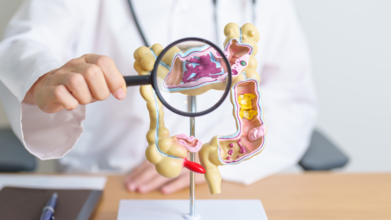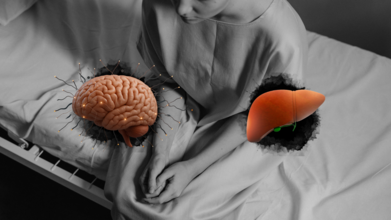- Health Conditions A-Z
- Health & Wellness
- Nutrition
- Fitness
- Health News
- Ayurveda
- Videos
- Medicine A-Z
- Parenting
- Web Stories
Colon Cancer Screenings Help Catch The Deadly Disease Earlier - Is Pencil Thin Stool A Sign Or Myth?

(Credit-Canva)
A growing number of people under 50 are being diagnosed with colorectal cancer. Colon cancer is the second leading cause of cancer-related deaths for both men and women and the expected death toll from it in 2025 is about 52,900 (American Cancer Society).
Recent research suggests that while a new push for earlier screening has led to more early-stage diagnoses, it doesn't fully explain the overall increase in cases among younger adults. The rise in diagnoses for this age group actually began in the mid-1990s and includes more advanced cancers as well.
What Caused The Increase In Earlier Colon Cancer Diagnosis?
In recent years, major health organizations like the American Cancer Society and the U.S. Preventive Services Task Force lowered the recommended age for average-risk adults to start getting screened for colorectal cancer from 50 to 45. This change has already had a positive effect.
Two recent studies from the American Cancer Society, published in the medical journal JAMA, show that this new guideline is helping catch cancer earlier. The first study found that the number of adults ages 45 to 49 getting screened jumped from about 20% in 2019 to nearly 34% in 2023. The second study found that early-stage diagnoses in this age group increased by 50% in just one year. This means that a lot of these cancers are being found when they are easier to treat and before they become life-threatening.
What Are The Symptoms of Colon Cancer?
Even with the new screening age, many people who are diagnosed with colorectal cancer are still too young to be eligible for screening. This is why it's so important for everyone—regardless of age—to know the warning signs and talk to a doctor about any unusual changes. The most common symptom for younger people is rectal bleeding. Other key symptoms to watch for include:
- A lasting change in bowel habits or the shape of your stool
- Stomach cramps or pain
- A loss of appetite or unexplained weight loss
- Unexplained weight loss or fatigue
Pencil Thin Stool – Symptom or Myth?
However, this idea is largely a myth. It started in the late 1800s, and while it was dismissed by experts in the mid-1900s due to a lack of evidence, it somehow found its way back into medical textbooks.
A 2009 study published in the Digestive Diseases and Sciences journal explained that thin stool is usually just a sign of diarrhea. Because diarrhea is much more common than colon cancer, a change in stool size alone isn't a reliable warning sign. Sending patients for a colonoscopy based only on this one symptom isn't necessary. It causes patients to go through an uncomfortable and risky procedure they don't need, and it puts a strain on our healthcare system.
Instead of focusing on stool size, it's more important to watch for other, more authentic symptoms of colorectal cancer, such as the ones mentioned above. If you have these symptoms, you should talk to your doctor.
How Is Colon Cancer In Men Different Than Men?
While colorectal cancer is a serious health issue for everyone, a 2015 review in World Journal of Gastroenterology shows that women over the age of 65 have a higher death rate and a lower chance of survival compared to men of the same age. This suggests that the way we approach this cancer needs to be different for women. There are several important reasons why women might have a tougher time with colorectal cancer:
Tumor Location
Women are more likely to get cancer on the right side of the colon, which is often a more aggressive type of tumor. Standard screening tests may not be as effective at finding these tumors early.
Anatomy and Screening
The unique anatomy of the female colon can sometimes make colonoscopies more difficult, potentially leading to missed or delayed diagnoses. Additionally, social and cultural factors can sometimes cause women to put off screening appointments.
Treatment and Prevention
Men and women's bodies can react differently to the same cancer treatments. Some drugs can cause side effects that are specific to the female reproductive system. Also, most studies on dietary risk factors don't consider how a man's diet might affect him differently than a woman's.
Blocking Brain-Liver Signals Could Stop Cancer-Related Weight Loss, New Study Reveals

Credits: Health and me
Cancer does not only target tumors, it often comes with a cataclysmic side effect called cachexia, a syndrome that induces extreme weight loss by removing muscle and fat. It strikes about one-third of cancer patients and contributes to most cancer deaths. Cachexia has until now been largely unmanageable, adding to the difficulties confronting patients and physicians. But new findings are illuminating this enigma—and the solution may be found in an unlikely location- the connection between the brain and liver.
Cachexia is not normal weight loss. It's a multifaceted metabolic syndrome that leads to rapid draining of the body's energy stores, resulting in muscle wasting and fat loss even when food intake is sufficient. Cachexia patients typically experience poorer responses to cancer therapies, reduced quality of life, and greatly compromised survival rates.
The biological basis of the syndrome has long been a mystery to scientists, but a joint effort between scientists at the Weizmann Institute of Science in Israel and the University of Texas MD Anderson Cancer Center in the US has revealed an important part of the puzzle. The researchers, in a new study recently published in Cell, identify impaired communication on the brain-liver axis as a critical force behind cachexia.
What is The Critical Brain-Liver Connection?
At the core of this finding is the vagus nerve, a significant communications highway that connects the brain to most organs, including the liver. The vagus nerve is the key regulator of metabolism, hunger, and inflammation. Yet cancer-induced inflammation can disrupt this nerve's signals into dysfunction.
When the activity of the vagus nerve is interrupted, the metabolism of the liver is damaged. The body starts to metabolize its own muscle and fat reserves, resulting in cachexia's relentless weight loss.
What is striking about this discovery is the possibility of intervening. Dr. Naama Darzi and Dr. Aliesha Garrett and their research team discovered that selectively inhibiting signals along the right vagus nerve—using a procedure that is noninvasive and already approved for medical use—prevented cachexia from developing in mice. This treatment also enhanced their chemotherapy responsiveness and prolonged their lifespan.
The potential implications of this study are significant. Cachexia has long been a difficult disease to manage, and no widely successful treatments have been available. With the targeting of the brain-liver pathway, physicians could have a new means of keeping patients on their desired weight and muscle mass while undergoing cancer treatment. This would potentially enhance both their quality of life and treatment success.
As the nerve-blocking approach involves technologies that are already in clinical trials, opportunities for accelerated bench-to-bedside translation compared to conventional drug development time frames exist. The method presents a promising platform not only for cancer patients but also for other metabolic disorders in which organ communication fails.
The liver-brain link revealed in the cachexia study resonates with other recent research emphasizing the significance of organ communication in health and metabolism regulation. A Perelman School of Medicine University of Pennsylvania study, published in Science this week, showed how the internal clock of the liver communicates with the brain regarding feeding.
This study describes why those who work at night or dine at odd times usually experience metabolic issues like gain of weight and diabetes. The liver provides timing cues via the vagus nerve to the brain about whether meal times coincide with the body's inherent circadian oscillation. When this signaling is distorted—such as in nightshift workers—the brain overcorrects, resulting in excessive eating and metabolic derangement.
How Brain-Liver Discovery Affect Metabolic Disorders?
The similarities of these studies indicate that manipulating certain pathways in the vagus nerve may benefit a variety of individuals beyond cancer patients. In night workers, frequent travelers with jet lag, or anyone with non-traditional meal times, therapies that regulate liver-brain communication may decrease overeating and metabolic disease risk.
Future research aims to identify the exact chemical signals the liver sends to the vagus nerve. Understanding this dialogue in finer detail could open up targeted therapies for obesity, diabetes, and other chronic conditions linked to disrupted circadian rhythms.
The body is a network, not a collection of isolated parts. These studies highlight that health depends on how well our organs communicate, especially under stress like cancer or lifestyle disruptions.
For cancer patients, preventing cachexia by blocking brain-liver signaling is a significant breakthrough. It changes the emphasis from symptom treatment to addressing underlying causes. And for millions with metabolic disorders, it provides promise of new therapy based on the timing and communication of body processes.
Briefly, the brain-liver axis is becoming a strong target for enhancing health outcomes across a number of conditions. As clinical trials advance and our knowledge unfolds, this area of research may revolutionize the way we treat diseases associated with metabolism and weight.
Cachexia has been a dark cloud over cancer care, but finally, science is lighting the way. By shutting down aberrant brain-liver communication, scientists have opened a window to treatments that could save lives and enhance patients' quality of living with cancer.
New Study Finds Screen Time May Be Increasing Cardiovascular Risks In Kids’ Lives

That time has long gone when a simple thought of daily playtime with friends filled kids with immense excitement, daydreaming of rushing home from school to play outdoor games. In this digital era, where every hand has a phone and more kids are obsessed with online games than a cricket or a football match and adolescents are doomscrolling like there is no tomorrow, physical health has taken a backseat.
A rather concerning new study published in the Journal of the American Heart Association has revealed that each extra hour of leisure screen time, whether it is scrolling through social media, binge-watching cartoons, or playing virtual games, is linked to higher cardiometabolic risk in children and adolescents.
And this is not just about kids being “a bit inactive”. It is about blood chemistry, future heart disease risk, and the alarming way our digital age is setting up tiny bodies for big trouble later in life.
Cardiovascular disease (CVD) is the world’s leading cause of death, but its roots are often planted early in life. Childhood markers like insulin resistance, chronic inflammation, high apolipoprotein B-containing lipoproteins, and obesity can all set the stage for heart problems in adulthood.
The study, which tracked kids’ and teens’ habits alongside a comprehensive set of blood-based biomarkers, found that every extra hour of screen time raised cardiometabolic risk by about 0.08 standard deviations in children aged 6–10 and 0.13 in 18-year-old adolescents. It is significant enough to matter and enough to warrant a serious parental side-eye at that glowing rectangle in your child’s hand.
A Biological “Screen Time Fingerprint”
One of the study’s most intriguing findings was the discovery of a metabolomics signature, a set of 37 blood-based biomarkers that essentially form a biological “fingerprint” of screen time. These chemical changes in the blood were linked to metabolic shifts that predict higher cardiovascular risk.
For adolescents, the data went a step further: the fingerprint was associated with a higher predicted 10-year adult cardiovascular disease risk. In other words, by the time today’s screen-loving teens hit their late 20s, the early warning signs could already be showing up on their medical charts.
It Is Not All Doomscrolling
While the study is observational (meaning it does not prove cause-and-effect), it paints a compelling picture: screen time is not just stealing playtime; it is shaping kids’ metabolic futures. And the risk seems to work in a dose-dependent way. That means trimming screen time, especially in the evenings, could help nudge those biomarkers in a healthier direction.
Five Ways to Significantly Reduce Screen Time For Kids and Teens
Telling a child to “just get off your phone” is as effective as telling a cat to stop knocking things off the table. Instead, here are five slightly offbeat but surprisingly effective strategies for cutting back screen time:
1. Hiding Wi-Fi Router
Hide the router behind a daily challenge. Want Wi-Fi? You have got to earn it by doing something active, like 20 minutes of cycling, a round of badminton, or even cleaning the house.
2. Swapping Online Shows with Interesting Activities
Replace one streaming session with a home-made “show” of fun-filled activities. Kids get hooked on activities with time-bound tasks; they get competitive. Screen-free creativity is a cardio-friendly brain workout.
3. Reverse Bedtime Stories
Instead of you reading to them, have them “read” or narrate a story to you. Teach them the skill of modulation and pronunciation and to make it even spicier, assign them characters for acting it out. This pulls them away from screens while boosting language skills and winding them down for earlier sleep.
4. Family Screen Swap Hour
Pick one hour each evening where everyone swaps screens for a shared activity, like board games, cooking, or a walk outside. The key is doing it together so no one feels singled out.
5. The “Leave It at the Door” Rule
Phones and tablets stay outside bedrooms. Create a charging station in the hallway, and make it a family-wide ritual. Fewer late-night scrolling marathons mean better sleep and, as the study shows, potentially better heart health.
The research is clear that screens are shaping more than attention spans. They are etching metabolic patterns into kids’ bodies that could carry over into adulthood. While technology is here to stay, our habits do not have to be static. And a little less scrolling, a little more moving, and a bit more sleep are any day better for your general wellbeing.
Man Killed Eating Broccoli Sandwich, 9 More Rushed To Hospital, All Linked To One Street Vendor In Italy

Credits: Canva
A 52-year-old man has died and 9 others have been hospitalized in Italy after eating a broccoli and sausage sandwich suspected to be contaminated with a deadly toxin. All cases have been traced back to the same street vendor on the seafront of Diamante, in the province of Cosenza.
Victim Fell Ill During Drive Home
The victim, identified as artist and musician Luigi Di Sarno, was returning from a family vacation in Calabria when he and relatives stopped at the food truck. All five family members ate the same sandwich and soon developed symptoms consistent with botulism.
Di Sarno reportedly began feeling unwell while driving along a highway near Lagonegro in Potenza. He pulled over in the town of Basilicata, where emergency services were called, but he died before reaching the hospital. Two of his relatives remain in serious condition.
Rare But Deadly Illness Suspected
Botulism is caused by toxins from Clostridium botulinum bacteria, which attack the nervous system, leading to breathing difficulties, muscle paralysis, and, in about 10% of cases, death. The infection is rare but can occur when certain foods, including broccoli, are improperly processed or stored.
Authorities believe contaminated broccoli in oil used for the sandwiches is the likely source. Local prosecutors in Paola immediately ordered all jars of broccoli in oil to be seized, along with the food truck where the meals were prepared.
Wider Health Concerns Across Italy
The outbreak has sparked nationwide concern. Just weeks earlier, eight people were hospitalized after eating contaminated guacamole at a food festival in Sardinia. Those cases were also linked to botulism.
In both incidents, Italy’s strict emergency protocol for botulism was activated. The Calabria Region’s Department of Health and Welfare confirmed that the Poison Control Centre in Pavia is the only facility authorized to manage such cases. The Ministry of Health stores the antitoxin in secure locations and distributes it solely through the Lombardy center.
The first doses of the antitoxin were sent from the Military Pharmacy in Taranto to treat initial patients. As more cases emerged, additional supplies were rushed in. Health officials have now ordered a nationwide recall of broccoli products to prevent further infections.
An autopsy will be conducted to confirm Di Sarno’s exact cause of death, though investigators say early evidence strongly points to botulism. Authorities continue to trace all potential exposure points while urging the public to avoid suspect broccoli products until the source is fully contained.
What Is Botulism?
As per the World Health Organization (WHO), foodborne botulism is a serious, and fatal disease, though it is relatively rare. It is an intoxication caused by ingestion of potent neurotoxins, the botulinum toxins, which are formed in contaminated foods.
WHO notes: "spores produced by the bacteria Clostridium botulinum are heat-resistant and exist widely in the environment, and in the absence of oxygen they germinate, grow and then excrete toxins. There are 7 distinct forms of botulinum toxin, types A–G. Four of these (types A, B, E and rarely F) cause human botulism. Types C, D and E cause illness in other mammals, birds and fish."
Common Symptoms
- Flaccid Paralysis that can cause respiratory failure
- Fatigue
- Weakness
- Vertigo
- Difficulty in swallowing or speaking
- Vomiting
- Diarrhea
- Constipation
- Abnormal swelling
- Weakness in neck and arms
© 2024 Bennett, Coleman & Company Limited

